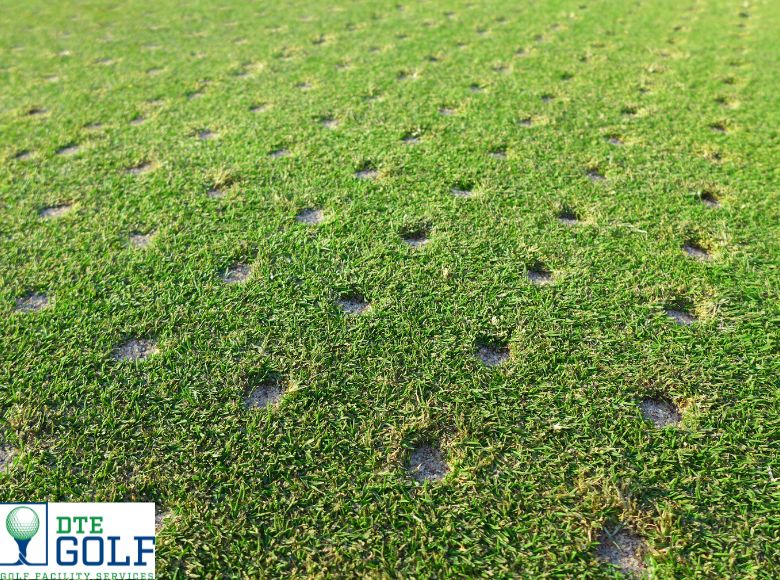Most golfers enjoy the feel of a true roll on the green, but few truly understand the process that keeps those putting surfaces firm, fast, and healthy—especially here in Florida. One essential practice often overlooked is aerating greens.
It may look like a messy interruption to your regular round, but there’s a reason the pros behind the scenes swear by it. If you’re serious about your game or simply curious about the health of your local course, here are five essential insights about aeration every golfer should have.

1. Aeration isn’t optional—it’s what keeps greens alive.
Florida’s warm, humid climate is both a blessing and a challenge. On one hand, the grass grows quickly. On the other hand, the soil beneath the greens becomes compacted from daily traffic, rolling machinery, and intense sun. Compacted soil doesn’t let roots breathe. Oxygen gets pushed out, water can’t soak in, roots start to suffocate and turf health worsens.
Aerating greens is the solution to this problem. It breaks up that compacted layer, opening up space for water, nutrients, and air to reach the roots. This isn’t just a turfcare suggestion—it’s a survival tactic. When the greens are aerated, they’re given room to grow deeper roots and stay strong, especially during Florida’s brutal summers.
2. Timing the aeration right makes all the difference.
If you’ve ever wondered why aeration often happens during spring or fall, it’s because the turf is actively growing during those seasons. In Florida, many superintendents prefer to aerate in late spring or late summer. The turf heals fast during those periods and takes full advantage of the open soil. If done during extreme heat or dormancy, the turf could take much longer to recover—or even suffer permanent damage.
Good golf maintenance plans take Florida’s unique climate into account. Rainfall, soil temps, humidity—all of it matters. Proper timing allows the course to get back in shape fast, keeping play disruption to a minimum. This is one of the most important reasons to trust a team that understands local conditions.
DTE Golf® offers turf strategies for greens that fit Florida’s climate and golfer expectations—without unnecessary guesswork.
3. Not all aeration methods are created equal.
There’s more than one way to aerate a green. The method used depends on the course’s condition, play schedule, and weather. The two most common methods are core aeration and solid-tine aeration.
Core aeration pulls small plugs of turf and soil out of the ground. This is excellent for reducing compaction and breaking up thick layers of thatch. It’s a little more disruptive, but it’s powerful.
Solid-tine aeration pushes solid spikes into the ground without removing soil. It’s less invasive and helps with gas exchange and water infiltration when recovery time is limited.
Most Florida courses use both methods throughout the year, balancing disruption with recovery. After any method, the greens are typically topdressed with sand to fill the holes, protect the turf, and smooth the putting surface. It’s a full process that demands both planning and expertise.
4. Aeration guards greens against play and weather shifts.
Between daily play and Florida’s quick-changing weather, greens face constant pressure. Foot traffic from golfers, mowing, rolling, and golf carts all contribute to surface wear. Then come afternoon storms, sudden downpours, and high humidity. Without aerating greens, all that stress causes drainage issues and weak root zones.
Golf course turf that can’t breathe or drain properly becomes shallow-rooted. Disease follows. Puddles form. Ball roll becomes inconsistent.. Eventually, the green starts to break down.
With regular aeration, greens recover faster from these conditions. Holes allow moisture to escape, roots to grow deeper, and oxygen to circulate through the soil. The result is a more durable, healthier green that can handle both the players and the weather.
Smart aeration practices are part of a bigger picture. DTE Golf® offers customized Florida golf course maintenance solutions that adapt to each green’s needs.
5. The recovery period needs proper care and patience.
After aeration, greens won’t look perfect. There will be visible holes, sand patches, and slower speeds. But this stage is necessary. Recovery typically takes 7 to 14 days in Florida, depending on the aggressiveness of the aeration and the turf’s overall health.
During this time, maintenance teams adjust mowing heights, modify watering schedules, and apply light fertilizer to support the turf’s recovery. Cutting too low or watering too much can stall regrowth. It’s a delicate balance.
Golfers may be frustrated during this window, but the payoff is worth it: faster, smoother, stronger greens that hold up longer throughout the season. When it comes to golf course maintenance, recovery care is just as important as the aeration itself.
Patience after aeration builds stronger greens. DTE Golf® offers expert golf consulting to guide recovery strategies that benefit both players and turf managers.
Florida Greens Need Florida Strategies
What works in one state doesn’t always work in another. Florida’s coastal winds, sandy soils, and year-round growing seasons all require local knowledge. That’s why generic aeration schedules and practices often fall short. From grass type to weather pattern, every factor affects how and when greens should be aerated.
Choosing the right method, the right timing, and the right recovery approach all matter. That’s the difference between greens that look okay for a few weeks—and greens that play great all year.
Golf Course Services Built for Florida – Powered by DTE Golf®
DTE Golf® provides services that support strong, healthy, and long-lasting greens throughout Florida, including:
- Aerating greens using core and solid-tine methods tailored to turf and soil conditions
- Topdressing and leveling services to protect roots and improve putting surfaces
- Golf course maintenance programs tailored to your seasonal needs
- Golf consulting to develop long-term turf strategies and player-focused solutions
- Florida golf course maintenance support that understands local climate, soil, and turf types
Get the greens your players will love and the turf your course needs. Let’s talk about turf solutions that work here in Florida.
